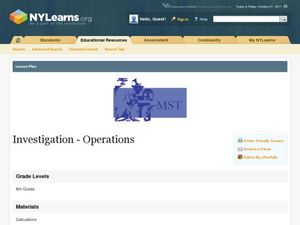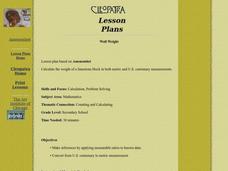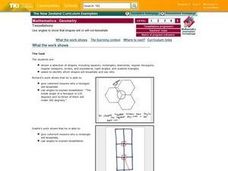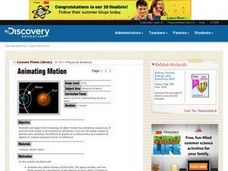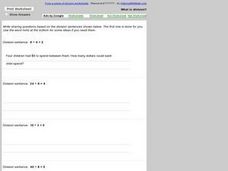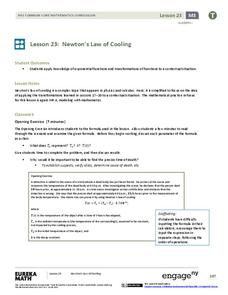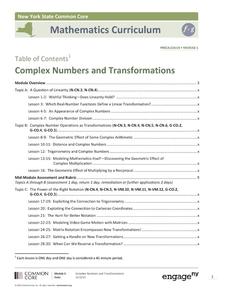Curated OER
Determination of the percentage of Acetic Acid in Vinegar
Students determine the concentration of acetic acid when the concentration of the base with which is titrated is known. They investigate how to weigh a sample using the balance, measure volumes using graduated cylinder, explore the...
Curated OER
Investigation-Operations
Sixth graders explore equations. In this math lesson, 6th graders discuss the rules for solving equations. Students apply the rules and solve various equations.
Pennsylvania Department of Education
Multiple Patterns
Pupils explore patterns that involve doubling numbers. In this multiple patterns lesson, students use objects to explore these patterns while recording them using a table. Pupils recognize even and odd number patterns while applying them...
Curated OER
Wall Weight
Eighth graders calculate the weight of a limestone block in metric and U.S. customary measurements. Make inferences by applying measurable ratios to known data.
Curated OER
Making The Height
Twelfth graders apply estimation techniques to determine how high any one basketball player can jump.
Curated OER
What was Newton's Idea of Science?
Students form logical foundations for analysis of observations. They improve analytic reading abilities through practice. Students investigate the foundations of scientific thought processes and how to apply them.
Curated OER
How much room?
Students examine the amount of usable space that exists in their classroom using square meters and square centimeters. They apply the information to predict the ideal size of a classroom.
Curated OER
Pigs and Ducks
Second graders use multiplication to solve problems. They use the multiplication facts for 2 and 4. Students combine operations to solve the problem and they devise and apply problem solving strategies.
Curated OER
Multiples of a
Sixth graders use problem solving strategies to evaluate linear expressions by substituting values. They substitute values for the letters in their names before applying the concept to other words. They complete worksheets in which they...
Curated OER
Parks Design Project
Students explore two dimensional geometric figures. They explore the relationships and measurements of geometric figures. Students apply proportion and scaling. They design a city park for students and teenagers.
Curated OER
Technology Lesson Plan
Students measure various objects using non-standard units. The goal is for them to practice measuring in order to apply the physical act to various objects found in the classroom. The lesson is ideal for the kinesthetic learners and...
Curated OER
Tessellations: Use Angles To Show That Shapes Will or WIll Not Tessellate
Students observe a selection of shapes. They identify which shapes will tessellate and justify their answer. Students apply the symmetry and angle properties of polygons to create tessellations.
Curated OER
Design an Apartment
Learners are given the task of designing an apartment. In groups, they practice estimating the area and perimeter of different shapes. After designing their space, they apply the same formulas to solving real-world story problems.
Curated OER
Spending=Q X P Module
High schoolers view a series of of short animated modules to relate the total spending in the economy to production and prices. They use this information to simulate the economy of a town called Spendsville. In the simulation, they...
Curated OER
Animating Motion
Students apply what they recall about objects in motion by animati ng sequences of pictures that model a set of physical conditions. They animate the orbital motions of the Earth, the space shuttle, and the Moon based on calculations of...
Helping with Math
What is Division? #2
Mathematicians are given three division sentences. They are to write a "sharing question," or basically, a word problem for each. They can apply the division concepts to teams and players, friends and presents, CDs and songs, albums and...
Curated OER
Multiplication Facts for 2,5, and 10
Young scholars practice multiplying by 2, 5 and 10. In this multiplication lesson, students participate in a teacher demonstration lesson of grouping for multiplication or making arrays. They concentrate on two's in this lesson and apply...
Curated OER
Literacy in Content Areas: Think Aloud
Fifth graders examine the "think aloud" reading strategy. In this reading strategies lesson, 5th graders apply the think aloud strategy to solving word problems in math.
Curated OER
Word Problem Comprehension
Eighth graders comprehend how to solve mathematics word problems. For this word problems lesson, 8th graders use word problems to examine possible answers and eliminate obviously incorrect ones. Students work with word problems in small...
Curated OER
Introduction to Density
Seventh graders define density in their own words. In this physics lesson, 7th graders solve density problems using its mathematical formula. They explain why some objects flow and some sink.
EngageNY
Newton’s Law of Cooling
As part of an investigation of transformations of exponential functions, class members use Newton's Law of Cooling as an exponential model to determine temperature based on varying aspects. The resource makes comparisons between models...
EngageNY
Complex Numbers and Transformations
Your learners combine their knowledge of real and imaginary numbers and matrices in an activity containing thirty lessons, two assessments (mid-module and end module), and their corresponding rubrics. Centered on complex numbers and...
EngageNY
Construct an Equilateral Triangle (part 2)
Triangles, triangles, and more triangles! In this second installment of a 36-part series, your young mathematicians explore two increasingly challenging constructions, requiring them to develop a way to construct three triangles that...
EngageNY
Overcoming Obstacles in Factoring
What do you do when factoring doesn't work? Learners complete the square when faced with quadratic expression that don't factor traditionally. They then use factoring by grouping to solve polynomial equations.



